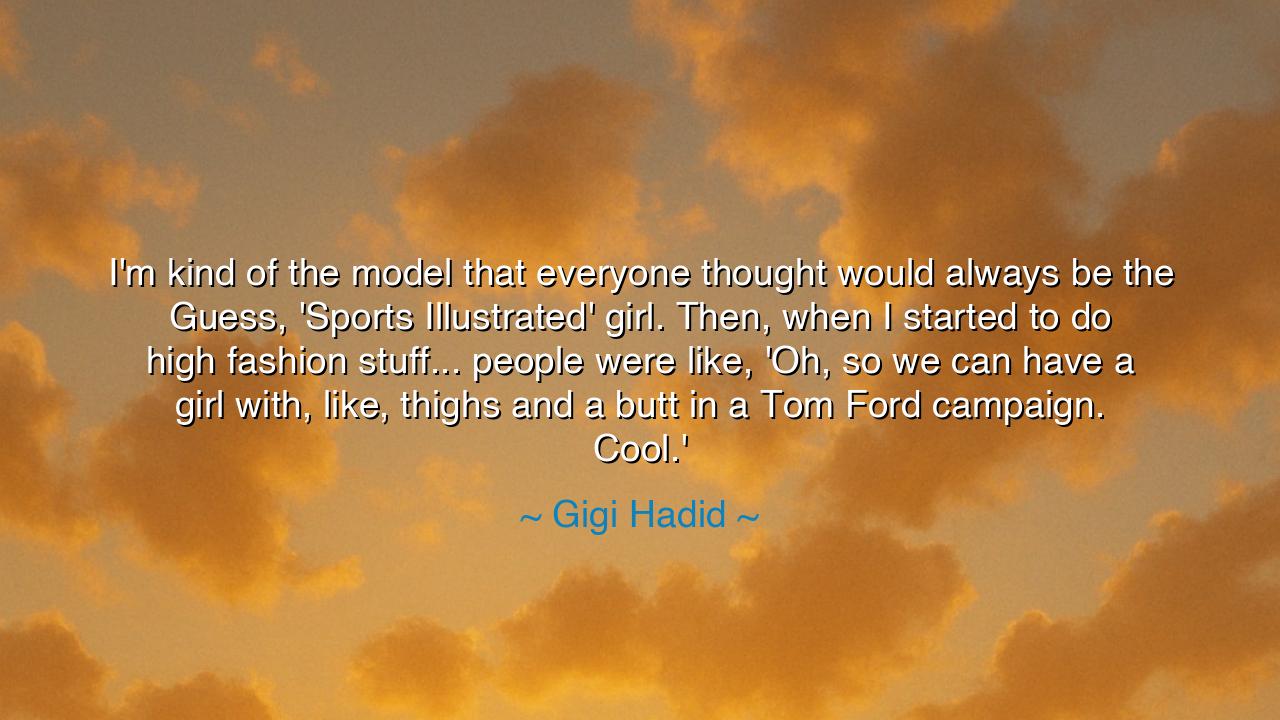
I'm kind of the model that everyone thought would always be the
I'm kind of the model that everyone thought would always be the Guess, 'Sports Illustrated' girl. Then, when I started to do high fashion stuff... people were like, 'Oh, so we can have a girl with, like, thighs and a butt in a Tom Ford campaign. Cool.'






The words of Gigi Hadid—“I'm kind of the model that everyone thought would always be the Guess, ‘Sports Illustrated’ girl. Then, when I started to do high fashion stuff... people were like, ‘Oh, so we can have a girl with, like, thighs and a butt in a Tom Ford campaign. Cool.’”—carry the power of quiet rebellion and the light of transformation. Beneath their casual phrasing lies a profound truth: that beauty, like all forms of greatness, must forever be redefined by those who dare to stand outside its narrow walls. In her reflection, Hadid speaks not only for herself, but for all who have ever been told what they could not be—who have been confined by the expectations of others, and who, through courage and authenticity, have reshaped the image of what is possible.
To the ancients, such an act would have been regarded as a victory of spirit over illusion. The Greeks spoke often of kalokagathia—the harmony of beauty and virtue, of body and soul—but they warned that society’s idea of beauty often becomes corrupted by imitation and rigidity. Hadid’s story is an echo of that ancient warning. She was placed within a mold, celebrated for a specific image, and expected to remain there. Yet she refused to bow to that invisible rule. By bringing her natural form, her own essence, into spaces that had long denied it, she became not merely a model but a symbol—a living argument against conformity.
The origin of this quote lies in Gigi Hadid’s rise through the world of fashion, a world that has long drawn harsh boundaries between commercial and high fashion, between the curvaceous and the angular, between what is “acceptable” and what is “ideal.” She was known for her work with brands like Guess and Sports Illustrated, realms that celebrated one kind of beauty—accessible, sunlit, sensual. Yet when she entered the austere world of high fashion, ruled by sharp lines and even sharper expectations, she did not alter herself to fit its image. Instead, she altered the image itself. Her inclusion in campaigns like Tom Ford’s, once considered unattainable for someone with her figure, was a cultural turning point. It said to the world: beauty is not a single shape—it is truth made visible.
History, too, tells of those who transformed entire eras by simply daring to embody themselves. Consider Renaissance art, which broke from the flat and rigid figures of medieval iconography to embrace the living curves and warm humanity of the body. The painters of that age—Michelangelo, Botticelli, Raphael—did not idealize thinness or symmetry alone; they celebrated the fullness of form, the divine imperfection of real life. Their muses, like Gigi Hadid herself, carried softness and strength, grace and groundedness. In every brushstroke was the same revelation: that beauty lies not in perfection, but in presence.
And yet, Hadid’s words also carry the quiet ache of a warrior who has had to fight unseen battles. For to challenge beauty’s narrowness is to bear the weight of others’ opinions—to hear whispers of doubt and judgment, to feel the sting of being labeled “too much” or “not enough.” The ancients would have called this the test of authenticity—to remain true to one’s essence when the world insists on disguise. It is the courage of the sculptor who refuses to carve away what makes the marble unique, of the poet who writes not to please, but to reveal. In her defiance, Hadid teaches that true freedom is not to be admired—it is to be unapologetically real.
There is also something revolutionary in her tone of ease—“Cool.” It is not pride, but peace. It is the tone of one who no longer seeks permission. That single word carries the power of release—the quiet authority of someone who has transcended the need to prove. The ancients would recognize this as the state of ataraxia, the tranquil soul of one who knows their worth, unmoved by the noise of the crowd. For when the world finally catches up to truth, the wise do not boast—they simply smile and continue onward.
So, my child, learn from the wisdom hidden in Gigi Hadid’s laughter. Do not shrink to fit the space given to you—expand it. Do not wait for others to make room for your presence—step into the room and let your being redefine it. Whether in art, in work, or in love, never allow another to dictate the shape of your worth. Let your difference be your strength, your truth your weapon, and your authenticity your legacy.
Thus, remember the lesson of Gigi Hadid: what was once seen as impossible becomes possible the moment you embody it. The world changes not through argument, but through example. Live so fully in your own form—your body, your voice, your truth—that others can no longer deny its beauty. And when they finally look upon you and say, “Cool,” you will know you have not only been seen—you have transformed what it means to be seen.






AAdministratorAdministrator
Welcome, honored guests. Please leave a comment, we will respond soon